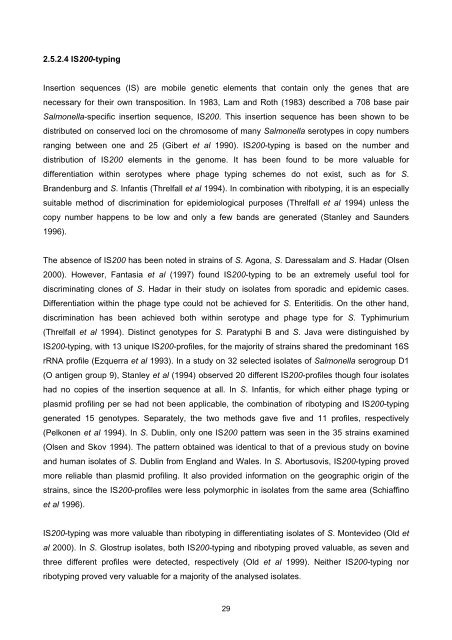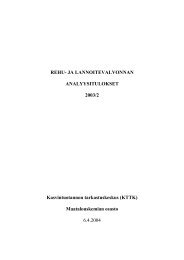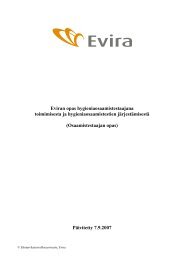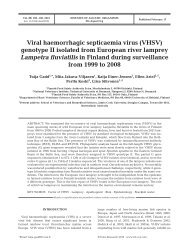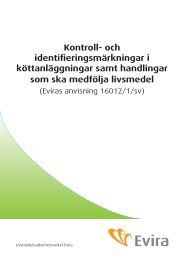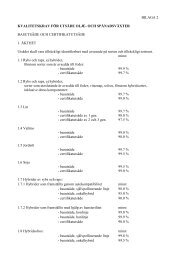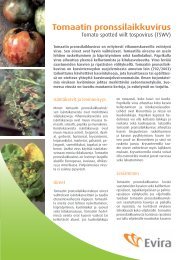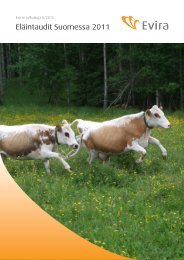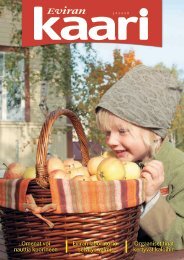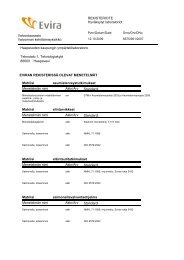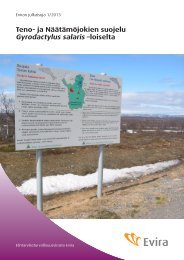Molecular characterization of endemic salmonella infections ... - Evira
Molecular characterization of endemic salmonella infections ... - Evira
Molecular characterization of endemic salmonella infections ... - Evira
Create successful ePaper yourself
Turn your PDF publications into a flip-book with our unique Google optimized e-Paper software.
2.5.2.4 IS200-typing<br />
Insertion sequences (IS) are mobile genetic elements that contain only the genes that are<br />
necessary for their own transposition. In 1983, Lam and Roth (1983) described a 708 base pair<br />
Salmonella-specific insertion sequence, IS200. This insertion sequence has been shown to be<br />
distributed on conserved loci on the chromosome <strong>of</strong> many Salmonella serotypes in copy numbers<br />
ranging between one and 25 (Gibert et al 1990). IS200-typing is based on the number and<br />
distribution <strong>of</strong> IS200 elements in the genome. It has been found to be more valuable for<br />
differentiation within serotypes where phage typing schemes do not exist, such as for S.<br />
Brandenburg and S. Infantis (Threlfall et al 1994). In combination with ribotyping, it is an especially<br />
suitable method <strong>of</strong> discrimination for epidemiological purposes (Threlfall et al 1994) unless the<br />
copy number happens to be low and only a few bands are generated (Stanley and Saunders<br />
1996).<br />
The absence <strong>of</strong> IS200 has been noted in strains <strong>of</strong> S. Agona, S. Daressalam and S. Hadar (Olsen<br />
2000). However, Fantasia et al (1997) found IS200-typing to be an extremely useful tool for<br />
discriminating clones <strong>of</strong> S. Hadar in their study on isolates from sporadic and epidemic cases.<br />
Differentiation within the phage type could not be achieved for S. Enteritidis. On the other hand,<br />
discrimination has been achieved both within serotype and phage type for S. Typhimurium<br />
(Threlfall et al 1994). Distinct genotypes for S. Paratyphi B and S. Java were distinguished by<br />
IS200-typing, with 13 unique IS200-pr<strong>of</strong>iles, for the majority <strong>of</strong> strains shared the predominant 16S<br />
rRNA pr<strong>of</strong>ile (Ezquerra et al 1993). In a study on 32 selected isolates <strong>of</strong> Salmonella serogroup D1<br />
(O antigen group 9), Stanley et al (1994) observed 20 different IS200-pr<strong>of</strong>iles though four isolates<br />
had no copies <strong>of</strong> the insertion sequence at all. In S. Infantis, for which either phage typing or<br />
plasmid pr<strong>of</strong>iling per se had not been applicable, the combination <strong>of</strong> ribotyping and IS200-typing<br />
generated 15 genotypes. Separately, the two methods gave five and 11 pr<strong>of</strong>iles, respectively<br />
(Pelkonen et al 1994). In S. Dublin, only one IS200 pattern was seen in the 35 strains examined<br />
(Olsen and Skov 1994). The pattern obtained was identical to that <strong>of</strong> a previous study on bovine<br />
and human isolates <strong>of</strong> S. Dublin from England and Wales. In S. Abortusovis, IS200-typing proved<br />
more reliable than plasmid pr<strong>of</strong>iling. It also provided information on the geographic origin <strong>of</strong> the<br />
strains, since the IS200-pr<strong>of</strong>iles were less polymorphic in isolates from the same area (Schiaffino<br />
et al 1996).<br />
IS200-typing was more valuable than ribotyping in differentiating isolates <strong>of</strong> S. Montevideo (Old et<br />
al 2000). In S. Glostrup isolates, both IS200-typing and ribotyping proved valuable, as seven and<br />
three different pr<strong>of</strong>iles were detected, respectively (Old et al 1999). Neither IS200-typing nor<br />
ribotyping proved very valuable for a majority <strong>of</strong> the analysed isolates.<br />
29


